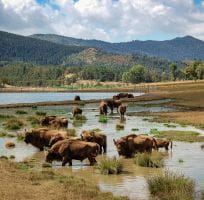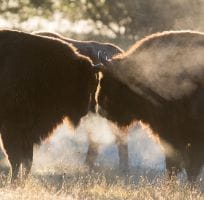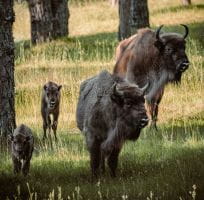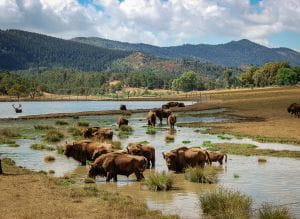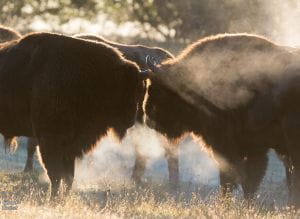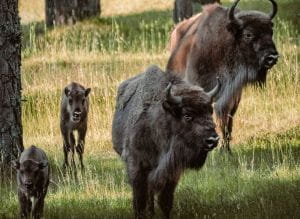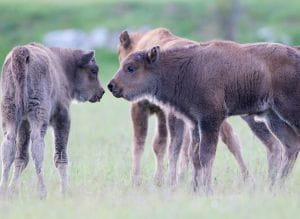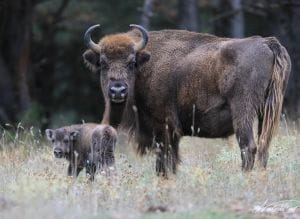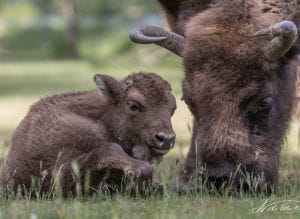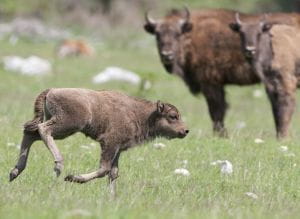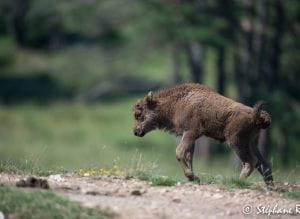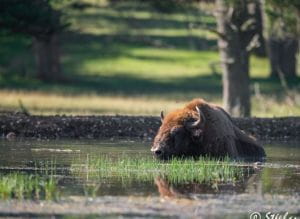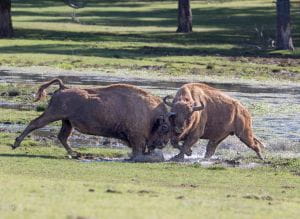The European BisonEurope’s largest land mammal
If there’s one thing the European Bison (Bison bonasus) hates, it’s being confused with its American cousin (Bison bison). For ten to fifteen thousand years they have been bedfellows and continents apart, ever since the last great ice age.
From this shared past, they have retained a similar appearance, even if there are a number of characteristics that make it easy to distinguish them. European bison stand straighter, their hump is less pronounced. Their horns are also less spread out, because they live in forests, unlike their relatives on the other side of the Atlantic, who only like the plains.
In terms of weight, the two cousins are equal, with a slight advantage for the American, who is built more roundly. The European male weighs around 800 kilos (900 kilos for the largest male of the European Bisons at La Réserve) for a height of 1.80 m; while the female makes do with 600 kilos.
This makes the bonasus bison the largest land mammal in Europe.
Life in societyWomen’s Day
The male bonasus bison is not sexist: he leaves the family herd of around fifty head under the shared leadership of adult females. He is content to exercise his right of lechery in late summer or early autumn. Unhelpful, he abandons the group when the calves are born, nine months later. The mother-to-be then isolates herself to give birth to a calf immediately on its feet. Ready to run away from the wolf!
Family societies are highly organised and perfectly supportive. So when a female gives birth, she generally surrounds herself with one or more bison who accompany her to the quietest places in the Reserve. Since 2010, real nurseries have been organised. The births appear to be synchronised and the young are born over a very short period. For 1 to 3 weeks, the mothers disappear into the heights where the newborns learn their first lessons, usually under the supervision of a single mother, the nurse. Meanwhile, the other females go about their business!
The dieta fine gourmet
The European bison is a gourmet. It likes to enhance its usual menu of herbs with bark, leaves and shrubs that it finds in abundance in the forest.
The ancestral domain
Of the bison in Europe
As recently as a thousand years ago, herds of European Bison roamed the entire continent as far as the Caucasus. Hunting, but also land clearance and the development of farming activities, eventually got the better of the humpbacked mole.
It disappeared from France between the 8th and 10th centuries, from Switzerland in the 11th century, and from Germany and Romania in the 17th century. By the end of the 9th century, only two wild populations remained. One, in the Bialowieza Forest, straddling the Polish-Bielorussian border, made up of “lowland” European Bison (Bison bonasus bonasus).
The other, in the western Caucasus, made up of “mountain” European Bison (Bison bonasus caucasius). The first subspecies disappeared from the wild in 1919, while the second survived for eight years before becoming extinct in its turn!
From then on the survival of the species was ensured only by 54 animals (29 males and 25 females) held in captivity with an established pedigree, i.e. not possessing American blood, and therefore genes.
The rebirth
The reintegration of bison in Europe
Of the 54 surviving animals from the 1920s, only 13 managed to reproduce, forming the genetic basis of all present-day European bison, both plains and mountain.
More precisely, the lowland European Bison (Bialowieza), of which the animals in La Réserve des Monts d’Azur are a part, are descended from 7 individuals (4 males and 3 females) of these 13. In 1923, enthusiasts founded the International Society for the Protection of the Bison bonasus.
Over the years, the population of European Bison has grown in the zoo. So much so, that from 1952, the Poles were able to start releasing animals into the Bialowieza forest. Other reintroductions followed, in Poland, Ukraine, Belarus, Russia and Lithuania. Today, the free-ranging bison population numbers 1,800. It is therefore larger than the captive population, which numbers 1400 individuals.
In 1996, a European programme for the European bison was set up at the initiative of the Poles. This imposed very strict rules on the exchange of breeding stock between zoos in order to reduce the risk of inbreeding.
Ensuring the survivalof bison in Europe
The Monts d’Azur Reserve’s herd of European bison comprises around fifty animals, three-quarters of which were born on the Reserve. In 2005 and 2006, we went to Poland to collect our animals, where they were carefully selected by Wanda Olech, coordinator of the European Bison Breeding Programme.
The aim of our Reserve is to create a population independent of those already existing in Poland and Belarus in order to increase the genetic variability of the species which is absolutely necessary to ensure its survival. Ideally, 2,500 bison would be needed, divided into five separate herds.
Biodiversity
Adaptation and positive influence
As our females imported from Poland in 2005 were just over a year old, we had to wait until 2008 to see the first births. There were exactly 9 for 11 three-year-old females, spread out from the end of April to the end of June. A remarkable result.
To our great satisfaction, the reserve’s European bison quickly made their mark in their new territories. During the first two years, they showed a clear predilection for forested areas, which they have profoundly transformed.
In fact, these brave beasts encourage the spread of seeds by carrying them on their fur and in their dung. These furry bulldozers also break low branches and shrubs, and strip the bark off trees to the point of killing some of them. They create gaps and even clearings in the forest, which encourages biodiversity. Because by penetrating back down to the ground, light allows many heliophilous species to thrive.
As a result, in areas of our reserve where there used to be fewer than ten plant species, there are now more than thirty.
The clearings created by our bison also benefit other animal species. Red deer, roe deer and hares need these clearings for their biological balance. In turn, these animals stimulate plant biodiversity. In the Monts d’Azur Reserve, for example, the Scots pine has regained its vigour and there has been a marked drop in the mortality rate of trees.
In less than three years after its arrival on the Reserve, the European bison has not only adapted perfectly to its new environment but has already significantly improved plant biodiversity.
The return of the lord of the forest, the European bison, is now a resounding success.
